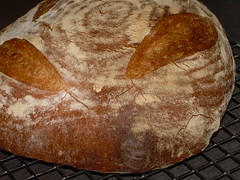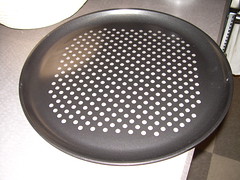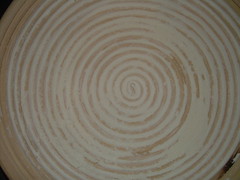It's the new school year, and, another year of school lunches.
Frankie's bread preferences for school lunch aren't in sync with what I've given her. She's currently in a PB&J phase and her bread of choice is the Giant Eagle "Italian." It's a squishy white semolina loaf with, dare I say, a very nice flavor.
I'm no snob when it comes to bread. I like my crusty artisan loaves and crackly baguettes, but I do love white squishy bread (and boloney and mustard). However, white bread has always been an insurmountable challenge. I've never been able to reproduce it in my kitchen. I dismissed it as an industrial process formulated with secret knowledge only Dick Cheney is privy to.
This morning, I studied all the labels in Giant Eagle's bread case and tried to identify the ingredients responsible for: volume, moisture retention, sweetness, texture and a preservative - although, if it's good, the preservative won't matter. Any loaf, good or manufactured will last at least a couple days. I was pleasantly surprised that I recognized most ingredients in the loaf she liked; my pursuit gained importance. The toughest attribute to reproduce in a home kitchen is volume. I've never been able to get that one. Moisture retention can come from whole grains, even in a low concentration (bulgur, semolina). Texture is usually tight, indicative of a fast straight dough process, also easy to reproduce. Sweetness - also pretty easy, a handful of sweeteners are all you need to play with.
Formulating any new dough, I start with 600 grams grain : 400 grams liquid (my standard starting place = 67% hydration) and a notepad.
Recipe
water, 390 g, near boiling
white vinegar, 10 g
bulgur, medium grind, 10 g
semolina, fine smeed, 40 g
salt, 10 g
yeast, dried, 1 packet (contains ascorbic acid)
vegetable oil, 20 g
sugar, 10 g
dextrose, 10 g
unbleached white, Montana Sapphire, 560 g
Process particulars
Straight dough method. Hot water and bulgur set until water cooled to 120°F. Then added everything and spun it in a bread machine dough cycle for 7 minutes, dumped into a container to rise at room temperature for an hour. Punched down and let rest for 20 minutes. Shaped into a batard on a floured counter and covered for 20 minutes. Slid whole thing onto my perforated stainless flat baking sheet.
Baking
Baked in preheated 425°F with 2 tablespoons water tossed in bottom for steam shot. After 5 minutes, cooled oven to 400 and let cook 40 minutes. After a few minutes, placed a loose foil tent over the top to prevent dark browning. Pale is the kid's preference.
Removed from the oven, let cool an hour and sliced.
 |
| Giant Eagle Mine |
Conclusions
Texture inside looks spot on.
Crust: tougher and more crisp than store bought
Taste? Kid will check it tonight at dinner.
Wife suggested cooler baking temperature and I think maybe a tad more shortening.
Any ideas?
Post mortem
Kid never got to taste it. It was obviously not the squishy white bread I yearned to make. I think the recipe was good, but the loaf was crustier, drier and didn't age well. I'll be trying different baking methods and will report back if I get something closer.











